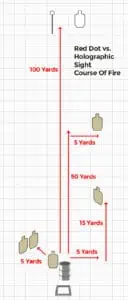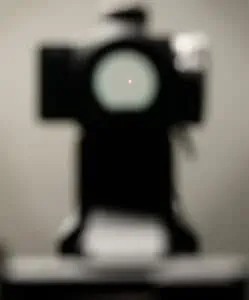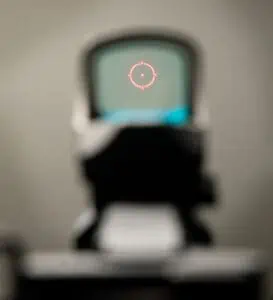Testing Red Dot vs Holographic Sights
For centuries, aiming a rifle meant lining up two or more little dots of metal so you could hit the target. This sighting system, otherwise known as iron sights, went through many twists and turns in search of something that would help the shooter make the shot quickly and accurately.
This started to change around the late 1800’s, as improvements in glass quality and gun accuracy made the optical sight a practical choice for almost any shooting situation. Since the mid-1990’s, there’s been a third option, the electronic sight. We’re going to look at two of the most popular choices out there in electronic sights, and compare the red dot vs holographic sight.
Red Dot Vs Holographic Sight Fast Facts
- Both sights project a laser onto a sheet of coated glass to produce a reticle
- Red dots are just a dot, holographic sights can project more information
- Holographic sights tend to cost more than red dots
In The Beginning, There Was The Laser
Arnold Schwarzengger using a laser-sighted AMT Hardballer in the first “Terminator” movie. It’s one of the most iconic scenes in action movie history, and it touched off interest in using a laser as a firearms sighting system. That interest would have to wait for a few years, however, until the size of the laser could be shrunk by using solid-state technology.
A few years later, Aimpoint (and others) realized that a laser projected onto a piece of silvered glass would give you a red dot aiming point, much like a laser spot projected onto the target itself. However, that dot is projected for just a short distance onto glass in a tube, much like other pre-existing optics. That in turn meant that the laser needed to create the dot could be smaller and use less energy than a laser sight that projected a spot on the target, and the red dot optic was born.
Another company, EoTech, took that technology one step further, and in the mid 1990’s came out with the holographic sight. The EoTech sight uses a hologram of a reticle that’s placed inside the optic. That hologram is then illuminated by a laser to create not just an aiming dot, but a crosshair or other reticle in the viewing window.
Comparing Red Dot vs Holographic Sights
Both a red dot and a holographic sight use a laser to project an aiming spot onto a piece of glass that’s held inside a tube which goes on top of your gun. However, that’s where the similarities end.
A red dot sight projects, well, a dot. In theory, at least. However, those of us who suffer from astigmatism can have problems with red dot sights. Astigmatism means your eyes have trouble focusing on both near and far objects, and that can cause the red dot to become… not a dot. With my eyesight, when I look through a red dot sight, I don’t see a dot. I see a blurry, vaguely dot-shaped blob that still gives me a distinct aiming point, but doesn’t have any clear, distinct edges.
The problem is worse when I use a red dot vs a holographic sight. However, it still happens with a holo sight. The difference is, the reticle in a holographic sight is three-dimensional. Rather than project a dot onto a reflective surface, the image is of a holographic reticle that is as thick as the glass that contains the reticle. This means that rather than having to focus on a particular point in space, my poor, tired eyes can focus on an object that has some depth to it because it’s a hologram.
Some Similarities, Some Differences
Another difference with a red dot vs a holographic sight is cost. The electronics inside a holographic are more complex than a red dot sight. This means that holographic sight is going to cost more than its red dot equivalent. It also means that a typical holographic sight is going to draw more power than a typical red dot, leading to comparatively shorter battery life.
Holographic sights also work well with magnifiers, as we found out in our earlier test versus a low power variable optic. Using a magnifier with a red dot sight increases the size of the dot, which is a problem if you’re unable to see a clear dot in your optic. Using a magnifier with a holographic sight gives results that rival or equal a low power variable optic, albeit at a higher price than an LPVO.
But what’s the performance of a red dot vs a holographic sight? To find out, we’re going to perform a similar test to our LPVO vs red dot test, and run each optic through the same course of fire and compare the results. The sights we’ll be using in this test are a Vortex Sparc Gen 2 red dot, which has a dot that is 2 MOA wide, and a Holosun HS510C holographic sight. We’re using these optics because they both represent what is available right now at the entry level for both sighting systems.
Putting Them To The Test
 The course of fire for the test is as follows. Starting position is low ready, behind a barricade. At the start signal, we’ll engage the first two USPSA paper targets from around a barricade to test how they handle fast target transitions from awkward shooting positions. We’ll then do a headshot at 15 yards to see how it works in close quarters, and then take two shots at a target 50 yards away. Each run will finish with a one shot each at a half-scale IPSC torso steel target and a six inch steel plate at 100 yards to see how each sight performs at longer ranges.
The course of fire for the test is as follows. Starting position is low ready, behind a barricade. At the start signal, we’ll engage the first two USPSA paper targets from around a barricade to test how they handle fast target transitions from awkward shooting positions. We’ll then do a headshot at 15 yards to see how it works in close quarters, and then take two shots at a target 50 yards away. Each run will finish with a one shot each at a half-scale IPSC torso steel target and a six inch steel plate at 100 yards to see how each sight performs at longer ranges.
We’ll shoot the test three times with each optic. Each miss on the steel targets will incur a five second penalty and we’ll score the paper targets as follows:
A Zone hit: No Penalty
C Zone hit: 1 Second Penalty
D Zone hit: 3 Second Penalty
Miss: 5 Second Penalty
The Results
| Raw Time | Penalties | Adjusted Time | |
|---|---|---|---|
| Run One | 13.81 Secs | 11 Secs | 24.81 Secs |
| Run Two | 12.14 Secs | 2 Secs | 14.14 Sec |
| Run Three | 12.45 Secs | 1 Sec | 13.45 |
| Average | 12.8 Secs | 4.67 Secs | 17.47 Secs |
| Raw Time | Penalties | Adjusted Time | |
|---|---|---|---|
| Run One | 11.54 Secs | 4 Secs | 15.54 Secs |
| Run Two | 10.27 Secs | 1 Sec | 11.27 Secs |
| Run Three | 11.47 Secs | 1 Sec | 12.47 Secs |
| Average | 11.01 | 2 Secs | 13.01 Secs |
Red Dot Vs Holographic Sight: What’s Best For You?
I must confess, before writing this article, my experience with holographic sights was limited. However, in that test, I was at least a second and half slower with a red dot vs a holographic sight, and even more so once scoring was complete. I’ve used a red dot on my AR for decades, first in competition, then as a general use / plinking optic. However, that may need to change. My engagement times were slower and I wasn’t as accurate with a red dot. I have gotten used to the fact that my eyesight is going to cause a red dot to blur. It appears that needs to change, and I need to think about switching to a holographic sight.
These results, however, are based on my experience and my eyesight. Your needs might be different. Budget also plays a role here. As we said before, holographic sights are, in general, more expensive than the equivalent red dot. You may have a need to make hits at longer ranges, at which point a low power variable optic might be your best choice. Your optic, however, is useless if your marksmanship isn’t up to the task. Hardware, like a red dot or holographic sight, can’t make up for a lack of rifle shooting fundamentals. Learn to shoot, then learn what optic works best for you.





IMHO, a red dot is useless beyond a practical distance of 25-50 yards on a rifle. If a person needs a scope, buy a scope. I have a Burris FastFire 3 red dot on my CMMG Mk9 with an 8.5-in barrel. My eyes suck, too, but for close-in work, it’s fine and does what it is supposed to do. I have LVPOs on 2 rifles, and those make a heck of a difference over what a red dot or holographic sight would make out to 100 yds and beyond. For what it’s worth. 🙂
You said, “a red dot is useless beyond a practical distance of 25-50 yards on a rifle.”
I think you left out a zero there, as red dot sights are good to 250-500 yards on a rifle (for man-sized targets), in the hands of a good shooter with good eyes shooting a flat-shooting cartridge. I know because I qualified as Expert at 300 meters using only iron sights. A red dot on a rifle is far more accurate than iron sights, so if you claim red dot sights are only good for 25-50 yards, would you claim that iron sights on a rifle are useless beyond a practical distance of 10-15 yards on a rifle? LOL
FYI, when I was in the Army, I consistently knocked down the 300-meter target using only iron sights, so I scored Expert on the M16A1 with iron sights, including 300-meter targets. If I’d had a red dot sight, I could probably have hit targets at 500 yards (although then I’d have to account for drop) — not “25-50 yards,” but more like 250 to 500 yards.
Where I hunt deer, a LONG shot would be 230 or so. Most are 120 or less. Rem 700 in 30-06 with a red dot is fine (and fast) for deer. I was a target only guy for about 10 years and got rid of my scope (heavy as all) and put a $200 red dot on it. It can be pouring rain and it is no problems.